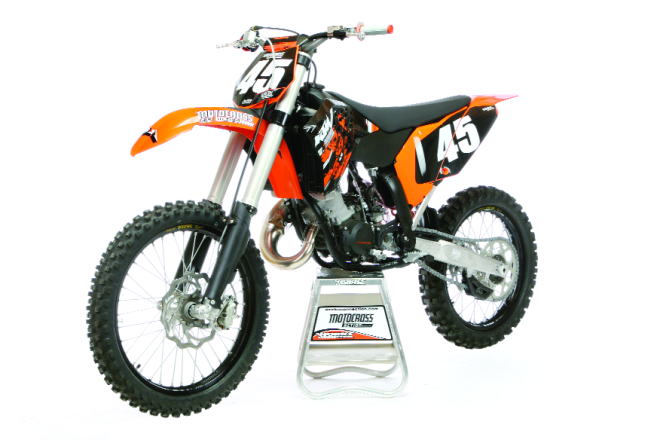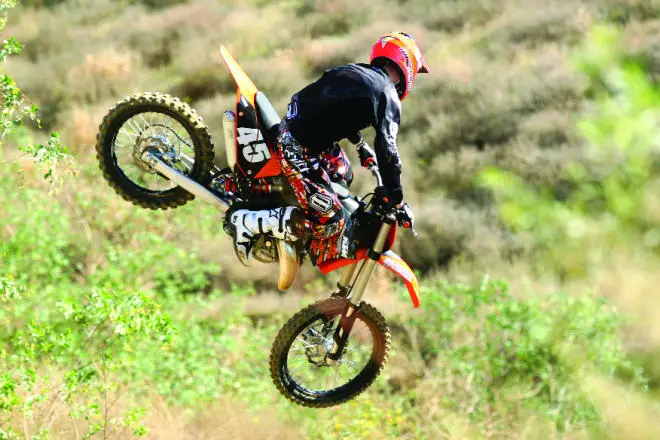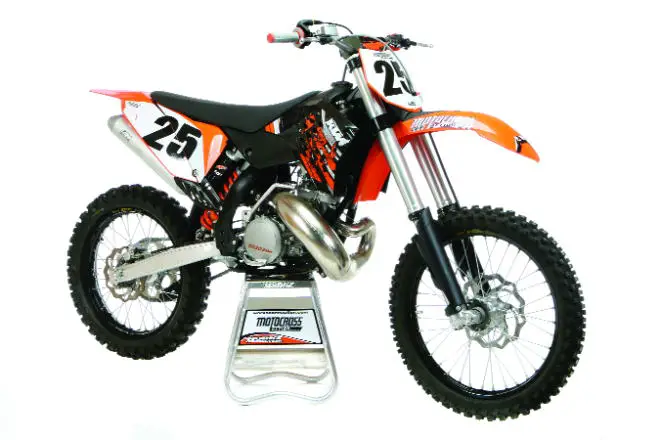2009 KTM 150SX AND KTM 250SX TWO STROKES:
You might consider this a test of rare, exotic and unusual machinery. Don’t let the fact that these are production bikes fool you into thinking that they aren’t extremely unique. They are. In a world where two-strokes are now considered pass‚, the fact that KTM builds a production-line, big-bore 125 and is one of only two of the major brands still producing 250cc two-strokes makes these two machines very special.
MXA doesn’t believe that the two-stroke is dead–dormant maybe, but under the current conditions, it just may be the machine of the future. Which is why we present this dual test of the 2009 KTM 150SX and KTM 250SX. (Editor’s note–This rule did not change)
RACE TEST: 2009 KTM 150SX

Q: WHAT’S THE DIFFERENCE BETWEEN THE 2008 KTM 144SX AND THE 2009 KTM 150SX?
A: The 2009 KTM 150SX actually retains the same 143.6cc displacement as the 2008 KTM 144. In essence, the 150SX is simply an upgraded 144SX with new numerical nomenclature. Here is a list of the updates for 2009:
(1) Top-end. A new piston and redesigned exhaust port are combined with a newly designed cylinder head for improved combustion and durability.
(2) Ignition. Two new ignition curves offer better adjustment of engine characteristics to adapt to different riders and tracks.
(3) Carburetor. When the 144SX made its debut, KTM may have overestimated the fuel delivery needs of the 20cc larger engine by spec’ing a 39mm carb. The 2009 KTM 150SX gets a Keihin PWK 38 carburetor (with a new intake manifold for improved throttle response and better power delivery).
Q: HAS KTM DROPPED THE TRADITIONAL 125SX OUT OF THE LINEUP?
A: No, but last year KTM imported twice as many 144s as 125s (and with good reason). In MXA’s comparison test between last year’s 125SX and 144SX, every MXA test rider preferred the broader, torquier and more potent powerband of the 144SX. As much as we love the idea of a high-revving 125, not very many riders sign up for the “125cc only class” at our local races.
Q: HOW MUCH DOES THE KTM 150SX COST?
A: The KTM 150SX retails for $6198.
Q: WHAT IS THE POWER LIKE ON THE 150SX?
On the dyno, the horsepower numbers favor the 150SX over the 125SX (and over the 250SXF also). The 2009 KTM 150SX tops 40 horsepower at peak and makes three horsepower more than the 125SX in the meat of the powerband.
Q: HOW IS THE GEARING?

Q: HOW IS THE JETTING ON THE 150SX?
A: Thanks to the new Keihin PWK 38mm carb, redesigned intake manifold and smaller exhaust port, the 150SX’s jetting was in the ballpark for MXA’s low-elevation SoCal racetracks.
Here are MXA’s jetting specs:
Main: 182
Pilot: 42
Needle: NOZI
Clip: Second (from the top)
Air Screw: 1-1/2 turns out
Q: HOW GOOD ARE THE WP FORKS?
A: The forks are a noticeable improvement over last year’s WP units. The stock springs were great for featherweights and kids stepping up from 80s, but if you are full-grown you might want to step up to a set of 0.44 kg/mm springs.
Q:WHAT WERE OUR BEST FORK SETTINGS?
A: Here are MXA’s fork settings for hardcore racing (stock settings in parentheses):
Spring rate: 0.42 kg/mm
Oil height: (380cc)
Compression: 13 clicks out (15)
Rebound: 18 clciks out (21)
Notes: Larger or faster riders will need stiffer fork springs.
Q: HOW GOOD IS THE WP SHOCK?
A: KTM is a strange cat when it comes to shock performance. One model will display bad habits, while another will be genteel. The KTM 150SX is a bike that seems to have the perfect power-to-weight ratio to work with KTM’s single-shock, no-link suspension system.
Q: WHAT WAS OUR BEST SHOCK SETTING?
A: Here are MXA’s shock settings for hardcore racing (stock settings in parentheses):
Race Sag: 105mm
Spring rate: 6.3 kg/mm
Low-speed compression: 14 clicks out (15)
High-speed compression: 3/4 turn (1 turn out)
Rebound: 17 clicks out (23)
Notes: As with the forks, full-sized riders will need the next stiffest shock spring (6.6kg)
Q: HOW DID THE KTM 150SX HANDLE?
A: Nothing handles like a 125?except a 150. The ultra-light Austrian two-stroke loves to change directions (and the suspension improvements only add to the 150SX’s natural handling advantages). With a quick blip of two-stroke power, you can use lines that 250 four-stroke riders wouldn’t dream of attempting.
Q: HOW ARE THE BRAKES ON THE 150SX?
A: KTM has the most powerful brakes in the biz. So powerful, in fact, that for 2009 KTM reduced the power to eliminate some of the previous grabbiness. Even so, the new brakes were still very touchy until we adjusted some play into the lever.
Q: WHAT DID WE HATE ON THE 150SX?
A: The hate list:
(1) Gas cap. The little orange button is a pain in the neck and becomes even more difficult with exposure to dirt. We take dykes and cut the tangs off of the gas cap’s locking mechanism–eliminating the locking feature.
(2) Gas tank. The absence of a raised lip around the gas cap makes it very easy to knock dirt down into the gas tank.
(3) Torx bolts. We don’t hate six-point Torx bolts. They look cool in the hardware store. We just don’t want them holding the rear sprocket on our bike. Also on the complaint list is the fact that KTM still uses 11mm and 13mm hex head bolts. Those aren’t standard-issue T-handle sizes.
(4) Graphics. Since the 150SX is most likely to be used by younger riders, the cartoon graphics almost make sense…almost.
(5) Black rims. After a few races, the black rims look more like spackled rims.
Q: WHAT DID WE LIKE ON THE 150SX?
A: The like list:
(1) Graphics. We hate the cartoon graphics, but are impressed that we get to hate them for so long. Thanks to KTM’s molded-in graphics, our KTM 150SX looked new after months of testing.
(2) Triple clamps. The black, CNC-machined clamps have adjustable bar mounts and can be flipped between 18mm and 20mm of offset.
(3) Hydraulic clutch. A two-stroke rider has a much different relationship with his clutch than a four-stroke pilot. We appreciate the self-adjusting capabilities of KTM’s hydraulic clutches after a hard moto of abusing it.
(4) Transmission. Six-speeds. Great.
Q: WHAT DO WE REALLY THINK OF THE 2009 KTM 150SX?
A: Kudos to KTM. When all the big-box, Japanese manufacturers have gotten out of the two-stroke business, we believe that KTM will still be building special machines for special people. The motocross world is a better place for having bikes like the KTM 150SX and hardcore companies like KTM. The 150SX is the perfect entry-level bike and competitive racer. It is a great counterpoint to the drone of four-strokes.
RACE TEST: 2009 KTM 250SX

Q: WHAT’S NEW ON THE 2009 KTM 250SX?
(1) Fork tubes. The WP forks’ new inner and outer fork tubes are lighter (and a different color). Amazingly, they come from Japan (most likely from the same place where the Big Four get their fork tubes). The new tubes are configured to feed more flex into the front end with less bending.
(2) Bottoming cones. The Dutch-built WP forks utilize new bottoming cones for more progressive damping at the end of the stroke.
(3) Shock. The Ohlins-licensed WP PDS shock features all new settings, a redesigned piston, better shims and a larger metering needle (up from 11.5 to 14mm).
(4) Brakes. A new Brembo front brake system features a floating two-piston caliper and 9mm master cylinder piston.
(5) Triple clamps. The triple clamps are black anodized, while still offering adjustable offset (18mm and 20mm).
(6) Radiator wings. The plastic shrouds are reshaped for better rider movement. The new graphics are molded into the plastic for extra durability.
(7) Engine covers. The clutch and ignition covers are also newly designed for greater durability.
(8) Chain. For 2009, the 250SX gets a high-end Regina unit.
Q: WHAT CHANGES DID KTM MAKE TO THE 2009 250SX ENGINE?
A: The 250SX engine stays the same for 2009. Why? Because in 2008 KTM made significant mods to the 250cc engine, including new engine cases, reduced volume around the reed cage, straighter intake tract, lighter connecting rod and redesigned oil flow around the connecting rod bearing.
Q: HOW GOOD IS THE 2009 KTM 250SX POWERBAND?
Some MXA testers wished the powerband were punchier, so it would help straighten them from high lean angles, blow out berms and increase the overall fun factor. Other testers liked the fact that the rear wheel was less likely to spin or step out in flat turns. But make no mistake about it, every test rider wanted more top-end over-rev.
Q: WHAT IS THE QUICKEST FIX FOR THE KTM 250SX POWERBAND?
A: As strange as it may sound, KTM’s stock muffler is a major downer in the powerband arena. We swapped the stock muffler for a Pro Circuit silencer (just the silencer, not the exhaust pipe) and the KTM ran much better on top. The powerband with the aftermarket silencer mimicked the stocker until the point where the stocker flattens out, and then it kept right on pulling. MXA testers had to remind themselves to wait to shift, and were rewarded handsomely for it.
Q: HOW GOOD ARE THE TIRES?
A: We have to ask ourselves, is Bridgestone giving a kickback to KTM’s purchasing agent? How else could anyone explain why KTM specs its bikes with a Bridgestone M70 rear tire that went out of vogue six years ago (and we thought it had gone out of production). This isn’t a great tire choice–unless you are still living in 2003.
Q: HOW GOOD IS THE GEARING?
A: At tracks where you can carry lots of momentum, the 13/48 final drive combination was adequate. At most tracks, the stock gearing was too tall, especially for the KTM 250SX’s power delivery. At these tracks, we opted for more teeth on the rear. The tighter gear ratio helped the bike accelerate harder off the bottom and get on the pipe sooner.
Q: HOW IS THE JETTING ON THE 250SX?
A: We had no problems with the 250SX’s jetting.
Here are MXA’s jetting specs:
Main: 158
Pilot: 42
Needle: NIEI
Clip: 3rd clip (from the top)
Air Screw: 1-1/2 turns
Note: We turned in the air screw half a turn (to 1 turn) when we installed the Pro Circuit silencer.
 Q: HOW GOOD ARE THE WP FORKS?
Q: HOW GOOD ARE THE WP FORKS?
A: In the past, we have struggled with midstroke harshness with the WP stuff–often opting to remove fork oil to mellow out the air spring effect. The latest batch of Dutch forks are notably better, and for most test riders we could get away with making clicker adjustments to achieve the plushness we wanted. These aren’t Kayaba SSS forks by any means, but they are on par with lesser Japanese forks.
Q: WHAT WERE OUR BEST FORK SETTINGS?
A: Here are MXA’s fork settings for hardcore racing (stock settings in parentheses):
Spring rate: 0.44 kg/mm
Oil height: 380cc
Compression: 9 clicks out (12)
Rebound: 18 clicks out (21)
Q: HOW GOOD IS THE 250SX SHOCK?
A: For 2009, the 250SX gets a stiffer shock spring (up from a 6.6 kg/mm to a 6.9). We liked the switch, but we felt the balance of the bike was skewed toward the front. This is a very tall bike with a teeter-totter feel that aggravates any type of stinkbug setup. We were willing to run the sag a little lower in the rear to bring the bike into balance.
A: Here are MXA’s 2009 KTM 150SX shock settings for hardcore racing (stock settings included in
parentheses):
Race Sag: 105mm
Spring rate: 6.9 kg/mm
Low-speed compression: 15 clicks out
High-speed compression: 1 turn (1-1/2 turns)
Rebound: 15 clicks out (23)
Notes: We used the high-speed compression adjuster to set the ride height of the 250SX in motion. Turning the dial in caused the bike to stay a little flatter at speed.
Q: HOW DID THE KTM 250SX HANDLE?
A: Thanks to its suspension improvements, KTM has taken another step toward the handling status quo. Yes, it still has that distinct “KTM feel,” but it’s edging ever closer to Japanese-bike feel. Part of the KTM 250SX’s prowess comes from its light weight. Getting off of a four-stroke and onto the 250SX is startling. At 208 pounds, the KTM is 30 pounds lighter than a KX450F, 18 pounds lighter than a CRF450 and 24 pounds lighter than a KTM 450SXF. You can feel the lightness (or, more accurately, you feel the heaviness of the other bikes).
Q: WHAT DID WE HATE ON THE 250SX?
A: The hate list:
(1) Silencer. Is it possible that KTM’s silencer is so ineffective as to kill the powerband? The answer is yes. The stock silencer holds the KTM 250SX back. The Pro Circuit muffler made a noticeable difference. It was quite a surprise.
(2) Handhold. The whale-tale rear plastics make it hard to put the bike on a stand. It’s a good thing the bike is light!
(3) Gas cap. Isn’t a locking gas cap the same as wearing suspenders to hold up your belt?
(4) Sprocket bolts. KTM holds its rear sprocket on with Torx bolts. Why not Whitworth bolts?
(5) Seat height. This bike is too tall.
Q: WHAT DID WE LIKE ON THE 250SX?
A: The like list:
(1) Brakes. The front is the best in the biz–260mm of pucker power!
(2) Maintenance. Someday we will look back on the cost of maintaining a two-stroke in the same way our folks reminisce about dollar-a-gallon gasoline. Most of the savings are in labor.
(3) Compression adjusters. The new fork dials are easier to turn.
(4) Triple clamps. The adjustable offset triple clamps are now anodized black, while the Japanese-made fork stanchions are no longer black.
Q: WHAT DO WE REALLY THINK OF THE 2009 KTM 250SX?
A: According to industry sources, KTM only imports 1000 motocross two-strokes to the USA a year (although they bring a lot more enduro and cross-country smokers), which is miniscule compared to their four-stroke production. On the other hand, there is something to be said for exclusivity when it comes to machinery. With the simple act of choosing to race a two-stroke, you have set yourself apart from the herd. A KTM 250SX culls the field even more.
For more info go to www.ktm.com






Comments are closed.